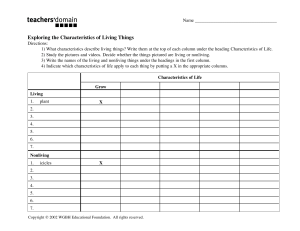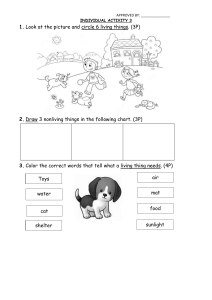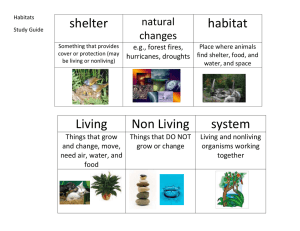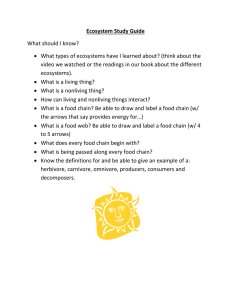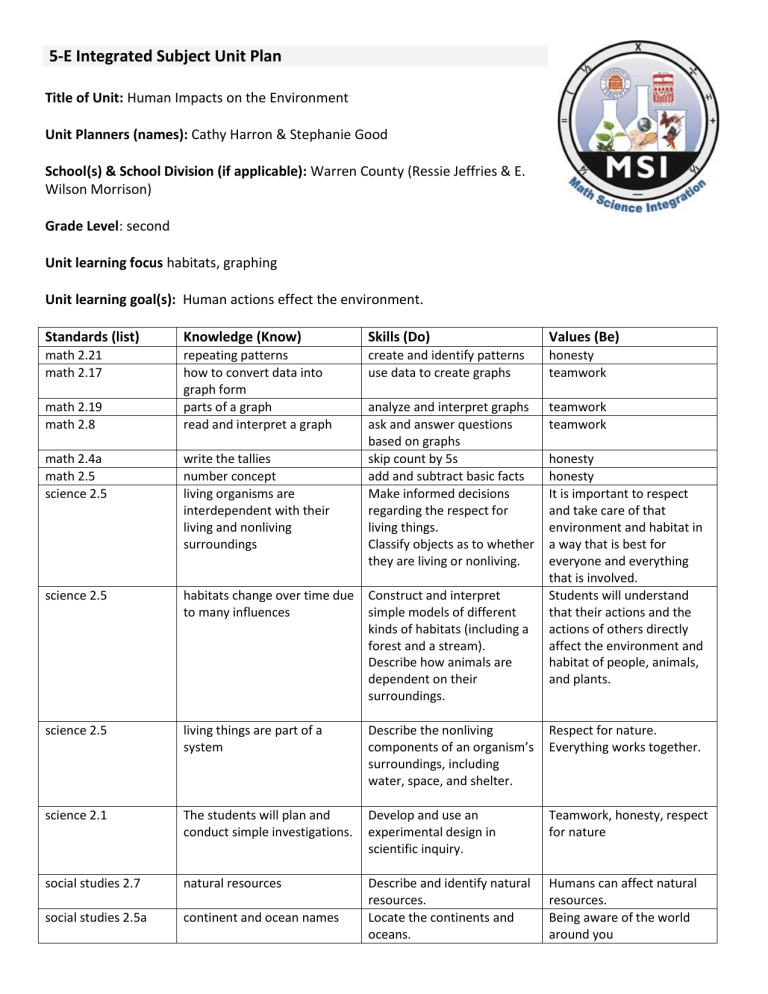
5-E Integrated Subject Unit Plan Title of Unit: Human Impacts on the Environment Unit Planners (names): Cathy Harron & Stephanie Good School(s) & School Division (if applicable): Warren County (Ressie Jeffries & E. Wilson Morrison) Grade Level: second Unit learning focus habitats, graphing Unit learning goal(s): Human actions effect the environment. Standards (list) Knowledge (Know) Skills (Do) Values (Be) math 2.21 math 2.17 repeating patterns how to convert data into graph form parts of a graph read and interpret a graph create and identify patterns use data to create graphs honesty teamwork analyze and interpret graphs ask and answer questions based on graphs skip count by 5s add and subtract basic facts Make informed decisions regarding the respect for living things. Classify objects as to whether they are living or nonliving. teamwork teamwork math 2.19 math 2.8 math 2.4a math 2.5 science 2.5 write the tallies number concept living organisms are interdependent with their living and nonliving surroundings honesty honesty It is important to respect and take care of that environment and habitat in a way that is best for everyone and everything that is involved. Students will understand that their actions and the actions of others directly affect the environment and habitat of people, animals, and plants. science 2.5 habitats change over time due to many influences Construct and interpret simple models of different kinds of habitats (including a forest and a stream). Describe how animals are dependent on their surroundings. science 2.5 living things are part of a system Describe the nonliving components of an organism’s surroundings, including water, space, and shelter. Respect for nature. Everything works together. science 2.1 The students will plan and conduct simple investigations. Develop and use an experimental design in scientific inquiry. Teamwork, honesty, respect for nature social studies 2.7 natural resources social studies 2.5a continent and ocean names Describe and identify natural resources. Locate the continents and oceans. Humans can affect natural resources. Being aware of the world around you social studies 2.6 how to hold a compass language arts 2.9 ability to read/comprehend at a second grade level language arts 2.13j what adjectives and verbs are language arts 2.7c what antonyms and synonyms are information that they’re sharing what nouns are how to write sentences language arts 2.3 language arts 2.13d language arts 2.12 Demonstrate map skills by constructing a compass. Students will read and demonstrate comprehension of nonfiction texts. Use adjectives correctly in sentences. Use knowledge of antonyms and synonyms. Share information orally Using tools Use singular and plural nouns Student will write simple explanations. observation skills communicate ideas through writing understand what you’re reading observation skills observation skills communication skills Attach a Concept Map that diagrams the relationships among the disciplines. Include science process skills and math problem-solving skills for your unit. Type of Integration: Thematic Integration Level or Extent of Integration Science Focus Systems concept(s): Humans can have a positive or negative effect on ecosystems. 5E Learning Cycle Instructional Strategies for our Unit Phase 1: Engage Capture student attention, activate student prior knowledge, stimulate thinking, raise key questions, etc. 1 Lesson 1. Items are groups ambiguously and students need to figure out why. They will also need to add a personal item to the correct group and justify their choice. Lesson 2. The class will go outside. Phase 2: Explore Allow students to observe, record data, isolate variables, design and plan investigations, create graphs, interpret results, develop hypotheses, and organize their findings. Lesson 1. Students will do the hands-on sort whole group Students will do a paper sort individually with living and nonliving objects. Students will create patterns with their living and nonliving objects. Questions: What characteristics are the same about each group? Lesson 2. Students will look at mulch/blacktop/grass areas to determine what is living and nonliving in each area. Students will record tallies for each living and nonliving object in each area. Students will create graphs based on the tallies they made. Students will ask and answer questions based on their graphs. Question: Ask them to look closer at the area to see everything in it. Phase 3: Explain Introduce laws, models, theories, and vocabulary. Guide students toward coherent generalizations, and help students understand and use scientific vocabulary to explain the results of their explorations Lesson 1. Living/Nonliving- model and real life scenarios, vocabulary poster What do the living things have in common? Lesson 2. Students will review the living and nonliving posters. Guide students to see that humans have a direct impact on their environment. Phase 4: Elaborate/Extend Provide students an opportunity to apply their knowledge to new domains, raise new questions, and explore new hypotheses. May also include related problems for students to solve. Lesson 2. Give students an area they haven’t observed (sandbox, wooded area…). Have them predict the amount of living things they would find there. Would there be more or less than what we found in the grass, mulch, and blacktop? Phase 5: Evaluate Administer formative assessment (although checking for understanding should be done throughout the lesson) 1 Phase descriptions adapted from Eisenkraft, Arthur. “Expanding the 5 E Model.” http://www.its-about-time.com/htmls/ap/eisenkrafttst.pdf Lesson 2. Posttest on living and nonliving things. Lesson Lesson 3 time= 1 hour SOL: science 2.5 math 2.8, 2.17, 2.19 language arts: 2.9 social studies: 2.7 Objectives/Activities Introduce habitats by watching “Habitats: Homes for Living Things” on www.discoveryeducation.com (15 min.) Five E stage Engage Discuss different habitats- show pictures of each and talk about key features. What type of animals would fit into each habitat? Why do they belong there? What resources do they need to survive? Explore Explain Read Animals Building Homes in Journey’s (second grade, story number 6). (Published by Pearson) Explain Pass out the animal sort paper and habitat graph. Students should cut apart the animals and sort them into their correct habitat on the graph. Have them come up with other animals they could put into each category on the graph. Spot check it to see if it’s correct. Ask questions based on the graph that they have to answer. Explore Elaborate Evaluate Lesson 4 time= 1 hour SOL: science 2.5 math 2.8, 2.19 language arts 2.3, 2.13j Differentiation: Struggling students can be given a graph/animals that they separate into land and water habitats. Other students will have a graph containing a variety of habitats/animals. Talk about different types of animals that were sorted on the habitat graph yesterday. What adaptations do they have to make them belong in that habitat? Explain Bring in an animal (or have a student bring in a Engage pet). Have students observe it, listing adjectives Explore and making notes about its appearance. Discuss Elaborate how these features are adaptations to help them survive. Talk about animal’s characteristics that will be on their game cards in the next activity. Tape a card on the back of each kid with a different animal’s name on it. Have students partner up and try to act out the animal on their partner’s back. They cannot use words. Tell Engage Explore Explain Evaluate them to only use verbs. After both have made guesses have a class discussion about the adaptations that they acted out. Lesson 5 time= 30 minutes SOL: science 2.5 Lesson 6 time= 1 hour SOL: science 2.5 social studies: 2.5a, 2.6 Differentiation: Assign students to certain partners based on ability. Animals on cards will range in difficulty. Teacher can read the animal name to students who can’t read well. Introduce camouflage. Have different colors of construction paper ripped into little pieces in baggies. Give each student a different color 4”x4” piece of construction paper and a bag of ripped pieces. Lay the small pieces on the big piece. Talk about which pieces are easiest to see. If the pieces were bugs and you were an animal that ate them, which ones would you eat? Why? Engage Explore Explain Discuss what would happen if the environment changed. (ex: What would happen to the arctic hare if it didn’t snow one year?...) Elaborate Introduce hibernation. Watch Brain Pop Jr. “Hibernation” video. Take the quiz afterwards. Students should write their answers on their whiteboards and hold it up to check for understanding. Engage Evaluate Introduce migration. Watch the Brain Pop Jr. Engage “Migration” video. Take the quiz afterwards. Evaluate Have students record and show their answers on their whiteboards. Look at a world map and draw the path Explain butterflies migrate. Discuss what continents it is on and how long it takes to complete its journey. Do the same with whales. Talk about cardinal directions and which direction these animals migrate. Students can act out “The oak tree, the caterpillar, and the fly catcher”. The Pied Flycatcher (bird) spends its winter in Africa and relies on the angle of the sun to know what to migrate to Europe. In Europe, when the leaves are on the oak trees there are lots of caterpillars. The flycatcher uses the caterpillars Engage Explore Evaluate as food after its long migration. Because of warming temperatures, the oak tree gets leaves too early, so the caterpillars come out early too. The flycatcher still migrates at the same time. Now when it gets to Europe there are no caterpillars left. Discuss human impacts on the environment, migration, and what adaptations the fly catcher will have to make to survive. Also discuss what could happen if the fly catcher cannot make any adaptations. Lesson 7 length= 45 minutes SOL: science 2.5 math 2.8, 2.17, 2.19 language arts 2.12 Discuss how people affect habitats. Explain Do the “Ethi-Thinking” activity on p.303 of Project Wild. Engage Explore Elaborate End by having students share their ways to help the environment. Evaluate Give posttest. Evaluate Select at least 2 of the lessons outlined in your unit plan and develop a full lesson plan for each. 5-E Integrated Subject Lesson Plan Title of Lesson: Living and Nonliving Lesson Planners (names): Cathy Harron & Stephanie Good School(s) & School Division (if applicable): Ressie Jeffries & E. Wilson Morrison (Warren County) Grade Level: second Lesson specific Science & Math SOL Students will classify living and nonliving things and will be able to create and explain individual mathematical patterns and begin to understand that living things and their environment should be treated with respect. Standards (list) Knowledge (Know) Skills (Do) Values (Be) Math repeating patterns create living and nonliving honesty 2.21 students will patterns create and identify patterns Science 2.5 what living and nonliving means distinguish characteristics of living things teamwork, honesty Level or Extent of Integration for this lesson (Mathematics Specific, Mathematics Focus, Balanced Math & Science, Science Focus, Science Specific): Instructional time: 1 hour Materials needed: a number of objects (mixture of living and nonliving), blank paper, magazines, vocabulary poster paper, pencil, crayons, scissors, glue Web resources used (if any; Give urls): none Advance preparation needed: find about 10 objects (some living and some nonliving), tell students to bring in one item from home for this lesson Formative assessment(s): The students will correctly sort the living and nonliving pictures, as well as create patterns with the pictures. Lesson Description (step-by-step teaching procedure): 1. Give pretest on animal environments and student survey. 2. Divide the objects you’ve chosen in the front of the classroom into living and nonliving groups. Have students brainstorm with each other to figure out why you’ve divided the groups this way. After they’ve determined how they think the groups are separated, they can one at a time add their item to the correct group. The class will give thumbs up or down to show if they think they’re right or not. (If the class disagrees, ask for reasoning for both sides.) Have a group discussion to figure out a definition of the word “living” and what makes something living or nonliving. 3. Give students a paper to fold in half. Write the words living and nonliving on the board and have them copy one to each side of their paper. Give students magazines. They are to cut out 5 living and 5 nonliving items. Have them sort and place the pictures on the correct side of their paper. (For students who struggle with writing, give them the prelabeled living/nonliving paper and have them trace the words. Cut out pictures for them to sort.) 4. Spot check the sorts to assess for understanding. When all the sorts are correct, have students place their pictures in a pattern. (ex. ABABA, ABBA ABBA…) Students will glue these patterns on the back of their sort paper. 5. Have students share the pattern they created with the class. The rest of the class will decide what the pattern is. 6. Conclude with anchoring the vocabulary in their minds. Put students in groups of 2-4 people and have them fill out the vocabulary poster for the word living. The poster includes the definition, a picture, examples or synonyms, and nonexamples or antonyms. 7. Have students share their poster. Be sure to point out the definition of nonliving when they get to the antonym section of living. Differentiation Strategies to meet diverse learner needs: Some students will fold a blank paper in half and label it living and nonliving, while others will be given a prelabeled paper and trace the words living and nonliving. Some students will be given premade sorts, while other students will need to find objects in a magazine to do their sort with. Attach Worksheets &/or Hand-outs: Homework Assigned (and applicable worksheets): no homework assigned for this lesson 5-E Integrated Subject Lesson Plan Title of Lesson: Living and Nonliving in the Real World Lesson Planners (names): Cathy Harron & Stephanie Good School(s) & School Division (if applicable): Ressie Jeffries & E. Wilson Morrison (Warrant County) Grade Level: second Lesson specific Science & Math SOL (or other standards covered). Describe desired gains in Knowledge/Skills/Behaviors for each, where applicable). These are your specific Learning Objectives for the lesson. Standards (list) Knowledge (Know) Skills (Do) Values (Be) Math tallies make tally marks for living teamwork, honesty 2.17 construct a and nonliving things graph how to read a graph 2.19 read a graph translate tally marks to a 2.8 ask and answer bar graph questions based on graphs ask and answer questions based on a bar graph Science 2.5 meaning of living and nonliving identify living and nonliving objects in different areas understand that humans effect the number of living objects in an area, respect for nature science 2.1 The students will plan and conduct simple investigations. Develop and use an experimental design in scientific inquiry. Teamwork, honesty, respect for nature Level or Extent of Integration for this lesson: Science Focus Instructional time: 1.5 hours Materials needed: 1 meter square areas in mulch, blacktop, and grass; pencil, living/nonliving tally paper, graph paper; completed living/nonliving posters from the previous day, crayons Web resources used (if any; Give urls): Advance preparation needed: teacher will need to mark off 1 meter square areas in the mulch, blacktop, and grass Formative assessment(s): Formative assessment- students can correctly identify living and nonliving things and translate that to tallies; students translate the tallies they’ve made to correctly fill out their graph; students can correctly answer questions based on their graph Lesson Description (step-by-step teaching procedure): 1. Discuss yesterday’s definitions of living and nonliving. Look at the posters students made the day before to remind them. 2. Divide the class into 3 groups. One group will visit the mulch section, one group will visit the grass section, and one will visit the blacktop section. Give students 5-10 minutes at each station before rotating them. 3. During each station students will tally the living and nonliving objects found in their section. Students will also draw/write what was found in each station. 4. Come back together as a class and discuss what was found in each section. Discuss why one section had more living things in than another. Try to get them to talk about human’s impact on the environment and what that means for animal/plant life. Keep tallies on the whiteboard for students who didn’t complete their chart to use to graph. 5. Pass out the blank graph form and discuss how it’s set up and the different parts of the graph. Have students translate the tallies on their chart to the bar graph. 6. Ask why some student’s graphs look different than other student’s. 7. Using only the graph, ask students questions like “How many more living things were found in the grass than nonliving things?” Have students make up one question to ask a partner about their graph. 8. Have students get into small groups. Say a different environment (such as a sandbox or a wooded area). Have students brainstorm in groups what kinds of living and nonliving things they would find there. Have them predict if there would be more or less than what they found in the mulch, the grass, and on the blacktop. Talk about why they thought this. 9. Give the posttest on living/nonliving things. Differentiation Strategies to meet diverse learner needs: Students who weren’t able to complete their own tally charts will use the data the class brings together and the teacher writes on the board. Some graphs have the parts labeled while others have blanks for students to label themselves. Roles can be assigned in each group- some people to observe, some to record tallies, some to draw the pictures or write the words. Attach Worksheets &/or Hand-outs: Homework Assigned (and applicable worksheets): no homework assigned Name _________________________________ Student Survey Circle every vocabulary word that you used with science: Living non-living, graphing, habitats, chair, environment, patterns, migration, tally, calendar, human impact, lemonade, skip counting, adaptations, bar graph, hibernation, migration, camera, song Circle every vocabulary word that you used with math: Living non-living, graphing, habitats, chair, environment, patterns, migration, tally, calendar, human impact, lemonade, skip counting, adaptations, bar graph, hibernation, migration, camera, song Were there any words that you circled in both science and math? Name _____________________________________ Animal Environment Pre/Posttest 1. Water, soil, and air are a. Living things b. Non-living things c. Plants d. Systems 2. Plants and animals are a. Living things b. Non-living things c. Plants d. Systems 3. What do animals and people need for habitats? a. Food, water, and clothes b. Food, water, shelter, and space c. Other animals, berries, and caves d. Caves, trees, forests, and dirt 4. When a bear grows a thick coat of fur and fat and falls into a deep sleep for the winter this is called a. Migration b. Habitat c. Hibernation d. Camouflage 5. The snowshoe hare changes its coat to match the seasons. In the winter it has white fur and in the summer it has brown fur. This adaptation is called a. Migration b. Habitat c. Hibernation d. Camouflage 6. Monarch butterflies migrate every year in the fall. What is one reason they migrate? a. To see a new place b. To escape predators that might eat them c. To go somewhere warmer for the winter d. They like to fly long distances 7. The bald eagle is our national bird. They live in high cliffs or rocks. A rock is a __________________ shelter. a. Living b. Non-living 8. The Cardinal is our state bird. The Cardinal lives in trees. A tree is a ________________________ shelter. a. Living b. Non-living 9. The Pied Flycatcher migrates from Africa to Europe in the summer. How has the temperature changed to affect this birds’ ability to survive? a. The temperature hasn’t changed, everything is the same b. The temperature has frozen all the leaves off of the trees c. The temperature has gotten colder and all the caterpillars have died d. The temperature has gotten warmer and all the caterpillars have turned to butterflies 10.Write a sentence telling one way you can help the environment. _________________________________________________ _________________________________________________ _________________________________________________ _________________________________________________ _________________________________________________ _________________________________________________ _________________________________________________ NAME: __________________________________________ REFLECTION/SUMMARY: Even though we were at two different schools, our data was very similar. When we gave the pretest, more than 50% of our classes showed no knowledge of the subject matter. When we gave the posttest, more than 90% of both classes understood the subject matter 80% or better. We also gave a survey on the integration of math and science to see if students understood that. What we found was that it was very difficult for seven year olds to know the difference between subjects. They had no prior concepts formed in their minds of “this is math because it is numbers, or this is reading because it is a book”. Both classes did, however, show that more students circled more words on the “this is math AND science” part after we had done our lesson than before. Students were very much engaged in the activities we did. In the future we will predetermine the areas to lay the hula-hoops and give strict instructions not to move them on their own. We also considered placing additional objects in the circles so that students in the blacktop area were occupied as long as the students in the grass area. Throughout the year both of us continued to integrate math and science. We also tried to tie in reading and even social studies as much as possible. We worked the content areas into our reading groups whenever we could. This was a wonderful workshop and we learned valuable skills that will help us and all of the students we teach in the future!
